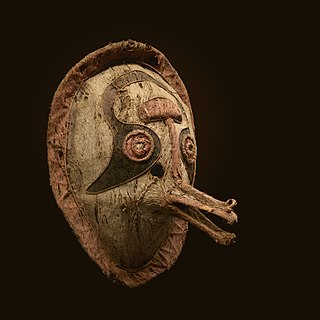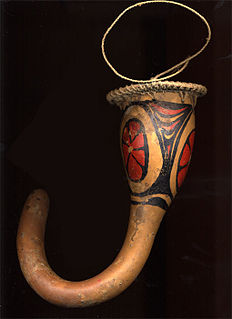 W
WThe culture of Papua New Guinea is many-sided and complex. It is estimated that more than 7000 different cultural groups exist in Papua New Guinea, and most groups have their own language. Because of this diversity, in which they take pride, many different styles of cultural expression have emerged; each group has created its own expressive forms in art, dance, weaponry, costumes, singing, music, architecture and much more. To unify the nation, the language Tok Pisin, once called Neo-Melanesian has evolved as the lingua franca — the medium through which diverse language groups are able to communicate with one another in Parliament, in the news media, and elsewhere. People typically live in villages or dispersed hamlets which rely on the subsistence farming of yams and taro. The principal livestock in traditional Papua New Guinea is the oceanic pig.
 W
WThe "Mudmen" of Papua New Guinea's Asaro tribe, also known as the Holosa, are those who wear a traditional costume centered around masks made of mud. They live nearby the village of Goroka in the Eastern Highlands Province of Papua New Guinea.
 W
WEharo masks were a type of mask used by the Elema people of the eastern Gulf of Papua as part of the "hevehe" cycle of masked rituals. These masks were crafted from barkcloth, vegetable fiber, and various pigments.
 W
WHaus Tambaran is a Tok Pisin phrase which describes a type of traditional ancestral worship house in the East Sepik region of Papua New Guinea. The most visually recognizable forms are from the Maprik area, with a tall and elaborately decorated front entrance wall where the ridge pole slopes down low toward the back of the building and the roof follows this decline and often continues all the way to the ground. The Sepik people are renowned for their superb artistic ability in painting and carving, which is often exhibited in these religious structures.
 W
WThe koteka, horim, or penis gourd is a penis sheath traditionally worn by native male inhabitants of some ethnic groups in New Guinea to cover their genitals. They are normally made from a dried-out gourd, Lagenaria siceraria, although unrelated species such as pitcher-plant Nepenthes mirabilis, are also used. They are held in place by a small loop of fiber attached to the base of the koteka and placed around the scrotum. A secondary loop placed around the chest or abdomen is attached to the main body of the koteka.
 W
WKula, also known as the Kula exchange or Kula ring, is a ceremonial exchange system conducted in the Milne Bay Province of Papua New Guinea. The Kula ring was made famous by the father of modern anthropology, Bronisław Malinowski, who used this test case to argue for the universality of rational decision making, and for the cultural nature of the object of their effort. Malinowski's path-breaking work, Argonauts of the Western Pacific (1922), directly confronted the question, "why would men risk life and limb to travel across huge expanses of dangerous ocean to give away what appear to be worthless trinkets?" Malinowski carefully traced the network of exchanges of bracelets and necklaces across the Trobriand Islands, and established that they were part of a system of exchange, and that this exchange system was clearly linked to political authority. Malinowski's study became the subject of debate with the French anthropologist, Marcel Mauss, author of The Gift. Since then, the Kula ring has been central to the continuing anthropological debate on the nature of gift giving, and the existence of gift economies.
 W
WKulap figurines of limestone or chalk were made in Melanesia. The small funerary sculptures from New Ireland were associated with death rituals. They are typical in the hilly Punam region of the New Ireland province in Papua New Guinea of the Bismarck Archipelago. They were believed to contain the soul of the deceased person whom they were meant to represent, and would be ritually smashed once their usefulness or the period of mourning was over. In more recent years, some have been sold in their intact forms to Westerners, particularly to German administrators.
 W
WNoken or bilum is a multifunctional knotted or woven bag, native to Papua Island. Its distinctive usage, which involves being hung from the head, is traditionally used to carry various goods, and also children.
 W
WPapua New Guinean art has a long rich diverse tradition. In particular, it is world-famous for carved wooden sculpture: masks, canoes and story-boards. Papua New Guinea also has a wide variety of clay, stone, bone, animal and natural die art. Many of the best collections of these are held in overseas museums.
 W
WThe wild man syndrome, also known as wild pig syndrome, is a culture-bound syndrome that affects the mental health of New Guinean males in which they become hyperactive, clumsy, kleptomaniacal, and conveniently amnesic." It is known in various languages of New Guinea as guria, longlong, or lulu.